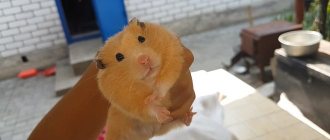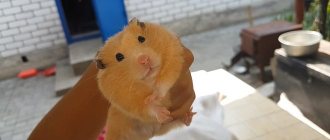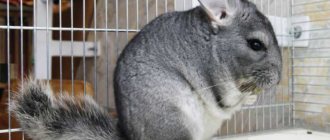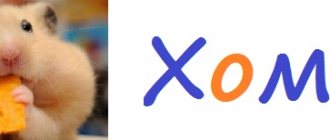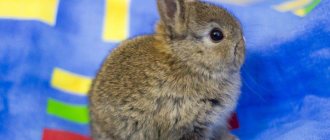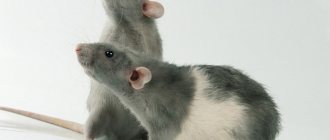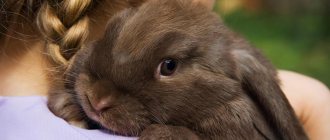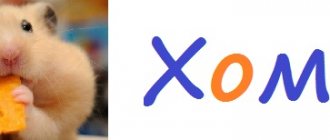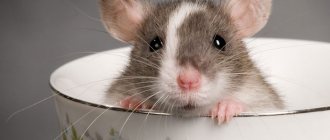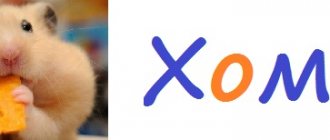Caring for baby chinchillas always falls on their mother, however, in order for the baby chinchillas to grow strong and healthy, the owner needs to take care of the female.
The main thing that needs to be ensured is a good and balanced diet, and this issue must be addressed during the chinchilla’s pregnancy, because it is during this period that the health of the puppies is established.
Pregnancy in chinchillas usually lasts 107-114 days; as birth approaches, the female becomes less and less active, usually she tries to lie on her side all the time. At this time, you need to provide a quiet and calm place for the chinchilla so as not to cause stress in the animal, because this can lead to premature birth or miscarriage.
It is worth noting that puppies that are born prematurely die in most cases. For newborn chinchillas you need to prepare a nest, for this you need to lay thin hay, it is important that it is dry, you also need to lay down the female's down and cover it with cloth, this way you will prepare a place for the puppies to be in the first days of their life.
If it is cool in your apartment where the chinchilla lives, then you will need to additionally insulate the nest, remember that the climate must be optimal, the health of the puppies will depend on this.
Most often, childbirth occurs at night, but it is possible that this will happen at any time of the day. Newly born puppies should already have teeth and fur, as well as open eyes. In the first hours of the cubs' life, you need to provide a large amount of water for the female, as she will drink a lot, and also leave the chinchillas alone, the female herself will wash and put the puppies in the nest.
What does a newborn chinchilla look like?
The female carries the young for 105-115 days, which is unusually long for rodents. Therefore, small chinchillas are born with teeth and dense fur, long mustaches and a fluffy tail, unlike baby hamsters, rats and other small animals. Their body is elongated, their legs are short, and their head is quite large.
A healthy chinchilla puppy weighs 35-70 grams. Weight less than 25 g means the calf is weak and will probably not be hatched.
Babies' fur is wet after birth, and if it is not dried immediately, the animals can easily become hypothermic and even die. The first thing they will do is start squeaking and looking for their mother, so after drying off they need to rest and feed near her.
Newborns' eyes are open, and after 7 hours the puppies are ready to explore the world around them. A day after birth, they are able to deftly jump, climb walls and climb onto upper shelves, which should not be allowed: a fall from a height ends in injury and death. Therefore, the cage with the cubs must have a roof, and all floors and furniture from there must be removed.
Species diversity
There are quite a few breeds of chinchillas and a variety of colors. To breed chinchillas at home, you need to choose only valuable colors, which cost from 8,000 rubles per child.
To choose the right male, you need to know the name of your breed. The male's coloration should roughly match the male's to ensure you get the right coloration in the cubs.
The main breeds of chinchillas:
- Albino;
- White recessive;
- White dominant;
- Pink and white;
- Beige dominant;
- Agouti;
- Foggy;
- Motley, etc.
To know which species can be crossed and which cannot, look at the genetic table.
What to do after the birth of a chinchilla
The number of chinchilla cubs depends on age: young chinchillas have 1-2 puppies in a litter, adults often have 3-6. When the babies' fur dries, they snuggle up to their mother's belly, warm up and eat. It happens that the female hides on the top shelf and leaves her offspring below, so it is recommended to remove all elevations from the cage. If this happens, the abandoned cubs need to be wrapped in cloth, fed with an artificial formula and placed next to the female.
When the kids have rested for a few hours, you can examine them. To prevent the mother from experiencing stress, she is distracted with a treat and carefully taken one puppy at a time. First, they are washed in warm water with laundry soap: another product will leave a foreign odor on the fur, due to which the female will refuse to feed the cubs. They are then examined to detect visible abnormalities and determine gender. A boy is distinguished by a distance from the anus to the urethra of 2-5 mm, which girls do not have.
Puppies are weighed after birth and every day for two weeks. All collected information must be recorded in a convenient form. Newborn chinchillas lose weight at first, but not more than 3 g per day, otherwise there is reason to worry about their nutrition. Starting on the third day, healthy pups should gain weight.
After 5-6 hours from birth, it is recommended to examine the anus of each puppy. If no traces of feces are visible near it, this indicates disturbances in peristalsis, which can lead to inflammation and prolapse of the intestine. In such cases, you should not try to cure the baby yourself; you should immediately contact a veterinarian.
Usually newborns see well, but sometimes their eyes are closed, most often due to debris. Then you need to carefully clean the eyes with a cotton swab moistened with chamomile infusion or plain black tea.
Prohibited Products
Among the fruits prohibited for consumption is persimmon. This healthy fruit is rich in iodine, which is contraindicated for animals. In addition to iodine, persimmon contains a lot of sugar and astringents, which leads to constipation.
It is also not recommended to feed beets to chinchillas.
The root vegetable is healthy, but has a laxative effect. In rare cases, small pieces of beets can be given for constipation. Any type of cabbage leads to strong gas.
Chinchillas love to eat tea rose petals - they have a pleasant taste and attractive aroma. There is no danger if you grow flowers in your own garden, but do not use store-bought flowers. They contain many pesticides and chemicals that can cause serious poisoning.
When removing tree branches for the winter, it is worth remembering which species are dangerous and not suitable for feeding.
Branches that should not be pruned:
- Apricot,
- White acacia,
- Beech,
- Aspen maple,
- Regular limegrass
- Cedar,
- Chestnut,
- Branches of any type of citrus fruit,
- Cypress,
- elderberry fruit,
- Cherries,
- Cherries,
- Branches of any coniferous species,
- Holly,
- Hydrangeas,
- Juniper,
- Common maple,
- Myrtle,
- Oleander,
- Plums.
Oak bark and twigs should only be given to animals suffering from diarrhea. In healthy animals they cause severe constipation.
The branches of stone fruit trees (cherry, cherry, plum, etc.) are dangerous because they contain a dangerous cyanide compound, which breaks down in the chinchilla's body to form hydrocyanic acid. If you feed a chinchilla with such twigs, it can cause not only severe poisoning, but also the rapid death of the animal.
Is it possible to touch newborn chinchillas?
To examine the cubs after birth, you need to thoroughly wash your hands with laundry soap to avoid infection. Any other means leave a smell that the mother will perceive as foreign, and there is a danger that she will stop feeding the children or even bite them.
At first, try to handle the babies as little as possible, remembering to wash them. It is better if only the owner does this to avoid odors, the possibility of infection or injury to the tiny animal. When the cubs are a month old, interaction with humans will be useful for them: in the future they will become sociable and affectionate.
Symptoms of approaching labor
It is necessary to monitor the female and know the symptoms of beginning labor. Before labor begins, it is necessary to change the bedding to fresh hay and remove the bathing suit.
The chinchilla gives birth on her own, she does not need help with this. The birth process is short and usually occurs in the morning, less often in the afternoon.
It is not difficult to determine that a female will give birth soon. If you keep an eye on your animal, you will immediately notice this change in behavior.
Symptoms of the onset of labor:
- The female's genitals begin to swell
- If you feel the female’s body, you will notice that the stomach seems to have sunk inward, and the ribs are sticking out.
- Nipples become enlarged and swollen
- The female is constantly stretching
- Prefers to sleep on his side
- Frequent urination
- Nose wet
- Cloudy discharge comes out of the vagina
How quickly and to what age do chinchillas grow?
- The average weight of a chinchilla puppy at birth is 55 g, but by the third week of life it grows to 100 g, and by the month it becomes three times its original weight - from 160 to 180 g.
- The speed of development and growth of small chinchillas depends on the quality of care and heredity. By the age of 9 months, they get used to adult food and reach a weight of 550-650 g. At this moment, the animal’s body is completely ready for reproduction.
- If some of the puppies are delayed in development, it is necessary to understand the reasons: sometimes large cubs push smaller ones away from their mother or feeder.
- After 1 year of life, chinchilla children shed their soft teenage hair and become covered with dense, beautiful fur for which these animals are famous. At 18 months, growth ends, young individuals look and behave just like adults.
The most important components of feed
The most important aspect in this regard will be the concentrated feed. Concentrated food will keep your pet active and cheerful. In the feeder you will find a variety of grains and seeds.
Ingredients for pets are beneficial as follows:
- Grain feed (corn, wheat, etc.) provides the animal with vitamins, starch, minerals, fats and lipids.
- Legumes will enrich your body with carbohydrates, proteins, potassium, calcium and vitamins.
- Unroasted pumpkin and sunflower seeds will provide your pet with a huge amount of vitamins.
Which grains are rich for the animal:
- Oats. Contains vitamins, proteins, fats, vitamins B1, B2, B6, K, carotene. For digestive disorders, oatmeal broth or oatmeal has a beneficial effect on the body. Oats are the basis of a cereal mixture for chinchillas.
- Barley. A very valuable grain product that fills the body with vitamins A, D, E, PP, B vitamins, as well as calcium, zinc, phosphorus, iron, copper, manganese and iodine. It is very rich in fiber. It should only be given to adults and preferably in terrestrial form.
- Buckwheat. A valuable dietary product, rich in vitamins and macroelements.
- Corn. Contains a lot of protein, but less oats. Do not feed too much to avoid causing bloating.
- Millet. It contains carotene. Red varieties are especially useful.
Most owners are more comfortable buying a box in a store than collecting such products themselves, choosing high-quality grains and seeds from the market. If store-bought products are more convenient for you, be careful.
When inspecting a package that is certainly not expired, you should not see any damage to the vacuum seal inside the box, any evaporation inside the box, or mold. Eating such food from a box is almost 100 percent harmful to shushi.
When to separate chinchillas from their mother
- Typically, cubs feed on mother's milk for up to 3 weeks, after which lactation begins to decline. A month after birth, very little milk is released, but if the babies live with their mother, she continues to feed them until 2-3 months.
- It is recommended that puppies be separated no earlier than they are 2 months old, and their weight should be at least 200 g. For small chinchillas, separation from their parent is a lot of stress, which can cause them to lose weight and slow down their development.
- After moving to a separate home, the cubs continue to be weighed at least 2 times a week. For the health of young animals, it is important to take care of high-quality nutrition: it includes grain and wet food, greens and vitamin supplements. It is also recommended to feed puppies with warm milk formula until they are 3-4 months old. Young chinchillas are capable of reproducing by 3 months of age, so males and females are kept separately: early pregnancy negatively affects the health of the animals. Young females are separated from their father at 2.5 months, but they can stay with their mother much longer. Male puppies are separated from their mother no later than 4 months. After 5 months, they cannot live with their father, otherwise conflicts will occur during puberty.
- They try to give the chinchilla to the new owner as early as possible, so she gets used to him faster and experiences less stress.
Feeding recommendations
It is not enough to know what you can and cannot feed your chinchillas. Proper feeding also means following a feeding schedule, keeping feeders and water bowls clean, and understanding your chinchilla's digestive system.
The first and most important rule is that there should always be enough hay and water in the cage for drinking. Feeders and drinkers must be clean. To do this, they should be disinfected regularly (at least twice a week) with boiling water.
Wooden feeders should not be used as they absorb odors and are a source of mold and mildew. Preference should be given to ceramic feeders that attach well to the cage and are easy to clean.
Chlorhexidine can be used as a disinfectant in the cage - it kills germs well and has no odor, but it is better not to use it for watering and feeding.
Some breeders also use regular laundry soap as a disinfectant. Water troughs, feeders and the cage can also be cleaned with alcohol. Keeping the cage clean is also necessary because sometimes the animal prefers to eat in the rest area or even in the house. Many owners have noticed how a chinchilla takes a piece of food and runs to the shelter.
It is also important to ensure that all products are fresh, clean, free from dust, rot and mold. It is recommended that you only buy prepared food from a reputable pet store.
All succulent food, as well as lettuce or spinach, should be thoroughly washed before being given to your pet. Branches and bark of trees offered to your pet should be well dried and free of traces of insects.
Vegetables and fruits for chinchillas should always be washed and cut into small pieces.
The animal should be fed at the same time and all residues should be removed from the feeder the next day. It is recommended to give rough food in the evening, and juicy food in the morning. If your chinchilla doesn't want to eat, change the food. The first reason for poor appetite is monotonous food.
New foods should be introduced gradually and in small portions. If you are unsure whether a particular food is suitable for your chinchilla, it is best to avoid it completely and add something that your chinchilla has already tried and enjoys eating.
Caring for newborn chinchillas
To take care of small pets, you need to arrange a safe home, give them good nutrition and maintain hygiene.
Since the cubs actively move immediately after birth, the entrance to the nesting house is blocked during the first days so that they do not get out. For the same purpose, the mother and babies are moved into a hamster cage or an additional layer of mesh with small cells is attached: there should be no more than 1 cm between the bars, the same applies to the ceiling. It is also recommended to remove shelves, hammocks, ladders from the cage - anything that can be climbed on and fall from a height.
A chinchilla baby normally gains about 2 g per day until the 5th day of life, and then from 4 to 8 g. For the first two weeks, they are weighed daily at the same time. Measurements are always recorded to notice any difference in weight gain.
The female has only 2, rarely 4, nipples, but if more puppies are born, not all receive the same amount of milk: strong cubs push the weak ones away from the breast and even attack them. In order for all babies to eat enough, the well-fed ones need to be seated and alternated near the mother every two hours.
A deep box with sawdust is suitable for depositing puppies; a table lamp is placed nearby for warmth. So that the cubs do not overheat and can hide in the shade, a shelter is made of cardboard inside the house.
If the female avoids the babies, pushes them away and hides, this is a sign of postpartum stress or hormonal imbalance. Perhaps she does not produce milk, then the offspring will have to be fed artificially.
Chinchillas gradually become accustomed to adult food from the first weeks of life, for which purpose drinking bowls and feeders are placed in the cage at a low height. If you fed the cubs with formula, from 2-3 weeks a separate drinking bowl is placed for it.
The nest and cage must be cleaned daily, changing bedding, food and water. To avoid infections, it is recommended to wipe the floor of the house and cages with salicylic alcohol.
Reproduction
When breeding chinchillas at home, you need to take into account that the animal is nocturnal and they like to mate at night. It is very difficult to catch them during the process. Mating lasts a few seconds, so you can skip it if you just go to the kitchen for a drink of water.
In order for mating to be successful, it is necessary to place the male only during the female’s hunting period, otherwise the female may refuse her lover.
Sometimes, to make sure that mating was successful, you need to look into the cage. Usually, after mating, there are scraps of fur lying around in the cage, which are not observed during normal times.
After mating, it is necessary to place the female in another cage and monitor whether it is replenished or not. If a chinchilla becomes pregnant, she usually gains 30-50 in the first two weeks. In this case, you need to feed with regular food and standard portions, otherwise it may turn out that you simply overfed the female.
When you are convinced that the female is pregnant, you need to make her diet more varied. In the diet you need to increase the amount of vitamins and microelements that are necessary for the proper growth of the cubs. We have a separate article about the diet of pregnant chinchillas.
What to feed newborn chinchillas
The first three days after birth, the female produces colostrum - a thick yellowish liquid, which differs in composition from milk and is necessary for newborn animals. Little colostrum is secreted; there is often not enough of it for a large brood, so the babies are fed with an artificial formula and alternated at the mother’s nipples so that everyone gets the nutritional fluid.
From 3-5 days until 3 weeks of life, chinchilla puppies feed mainly on milk. The amount of milk in a female does not depend on the brood, so there may not be enough for everyone. Lack of nutrition seriously harms the health of the cubs: the formation of the skeleton, the growth of muscles and adipose tissue are disrupted. It is important to detect in time that they are starving and begin complementary feeding. The following signs indicate this:
- no weight gain;
- babies squeak loudly;
- move little, sit still;
- They are chasing their mother, who drives them away.
Newborn animals grow faster when breastfed, so it is worth trying to establish lactation while introducing formula milk. To do this, take the chinchilla in your arms, gently massage the nipples and, if possible, squeeze out a few drops of milk. Such procedures are useful not only for feeding, but also for the prevention of mastitis.
Dried nettle helps stimulate lactation: the female is given it once a day for the first few days. If it does not work, the chinchilla is given an apilac tablet. It is better to make every effort to establish milk production, otherwise the cubs will have to be fed entirely by hand: every 2-3 hours in the first week (including night), 4 hours in the second and 6 hours in the third.
If a whole brood needs to be fed, the owner needs to look for another lactating female with excess milk. She will not accept other people's cubs, so first they are wiped with fluff from her house. Then, in the absence of the female, the babies are placed next to her offspring, and after 20 minutes they smell the same.
Infant formulas for newborn babies are suitable for artificial feeding, preferably lactose-free. Breeders also use Beaphar Kitty Milk powdered milk for kittens; it is diluted in a ratio of 1 to 1.5 with warm boiled water. There are tips on feeding babies with diluted cow's or condensed milk, but this should not be done: cow's milk causes diarrhea, damages the kidneys, and the sugar and fat in condensed milk are hard on the liver.
Main menu
The chinchilla's diet includes hay and twigs, a cereal mixture, vegetables, fruits, and berries. Herbs and nuts are given to chinchillas as a healthy and tasty addition. Large feed includes hay and tree branches.
This is the basis of the diet of rodents, whose gastrointestinal tract is adapted to digest food rich in fiber. Grass pellets contained in ready-made chinchilla feeds are not able to fully satisfy the animals' fiber needs.
Juicy food (vegetables, fruits, fresh herbs) is a source of vitamins and microelements for the animal’s body. You can feed your chinchilla these foods:
- pumpkin, carrots, zucchini, cucumber, parsley root, celery;
- apples, pears, melon, watermelon, seedless grapes, plums, bananas;
- fruits of rowan, hawthorn, cranberry, wild rose, barberry;
- dry meadow grass, legume leaves, dandelion, plantain and nettle leaves.
Purchasing ready-made specialized mixtures greatly simplifies the care of animal nutrition. The compound feed recipe was developed by scientists specifically for various groups of animals - young, pregnant and lactating females, adults. The composition meets the needs of chinchillas and is balanced in terms of protein and fat.
In addition to prepared feed, hay should be provided. From time to time the animal may be spoiled with treats.
To dry your grass, trim it when it is in bloom - this is when the nutrient and vitamin content is highest. It is better to dry it in the shade so that the hay remains green and fragrant. Various plants are suitable for harvesting:
- The chinchilla readily eats hay from meadow grasses (echinacea, broom grass, fescue, meadow fescue, bromeg, bluegrass, timothy).
- It is good if the hay contains chamomile, pie, sago, sycamore. These medicinal herbs are beneficial for the digestion of animals.
- Nutritious and tender bean hay from clover, alfalfa, sainfoin.
- Dried carrots and peas, corn, nettles and mint leaves make great additions to hay.
Store hay in canvas bags in a dry and dark place.
Hard food
In the wild, chinchillas eat wild grain seeds. At home, chinchillas can be fed a mixture of regular grains:
- Whole oats are easily digestible and do not cause obesity. The grain can be replaced with oatmeal.
- Corn is nutritious and rich in protein, but in large quantities it can cause bloating.
- Wheat is an abundant, environmentally friendly product.
- Barley – Served only crushed or crushed.
- Sunflower seeds, fed raw, are rich in the fatty acids your pet needs.
- Hemp and flax seeds are good for chinchilla digestion.
It is useful to give some of the seeds in germinating form, the germination size is up to 10-15 mm.
Treats
To pamper your pet, you can give your chinchilla:
- nuts (walnuts, cashews, peanuts, almonds);
- dried fruits (raisins, apricots, rose hips, apples and pears);
- pumpkin seeds;
- fresh berries (raspberries, currants, gooseberries, strawberries, raspberries, blueberries).
The most important thing to remember is that treats cannot replace healthy foods. Chinchillas love sweets and can endlessly ask for pieces of dried fruits or berries, rejecting regular food. This can lead to digestive problems. An approximate dose of treats for an adult is 1 berry, 1 nut or a piece of dried fruit the size of a hazelnut per day.
